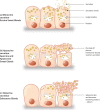Working Up a Good Sweat - The Challenges of Standardising Sweat Collection for Metabolomics Analysis
- PMID: 28798503
- PMCID: PMC5548369
Working Up a Good Sweat - The Challenges of Standardising Sweat Collection for Metabolomics Analysis
Abstract
Introduction: Human sweat is a complex biofluid of interest to diverse scientific fields. Metabolomics analysis of sweat promises to improve screening, diagnosis and self-monitoring of numerous conditions through new applications and greater personalisation of medical interventions. Before these applications can be fully developed, existing methods for the collection, handling, processing and storage of human sweat need to be revised. This review presents a cross-disciplinary overview of the origins, composition, physical characteristics and functional roles of human sweat, and explores the factors involved in standardising sweat collection for metabolomics analysis.
Methods: A literature review of human sweat analysis over the past 10 years (2006-2016) was performed to identify studies with metabolomics or similarly applicable 'omics' analysis. These studies were reviewed with attention to sweat induction and sampling techniques, timing of sweat collection, sweat storage conditions, laboratory derivation, processing and analytical platforms.
Results: Comparative analysis of 20 studies revealed numerous factors that can significantly impact the validity, reliability and reproducibility of sweat analysis including: anatomical site of sweat sampling, skin integrity and preparation; temperature and humidity at the sweat collection sites; timing and nature of sweat collection; metabolic quenching; transport and storage; qualitative and quantitative measurements of the skin microbiota at sweat collection sites; and individual variables such as diet, emotional state, metabolic conditions, pharmaceutical, recreational drug and supplement use.
Conclusion: Further development of standard operating protocols for human sweat collection can open the way for sweat metabolomics to significantly add to our understanding of human physiology in health and disease.
Conflict of interest statement
Competing Interests: None declared.
Figures
Similar articles
-
Nonocclusive Sweat Collection Combined with Chemical Isotope Labeling LC-MS for Human Sweat Metabolomics and Mapping the Sweat Metabolomes at Different Skin Locations.Anal Chem. 2017 Aug 1;89(15):7847-7851. doi: 10.1021/acs.analchem.7b01988. Epub 2017 Jul 19. Anal Chem. 2017. PMID: 28679039
-
Metabolomics analysis of human sweat collected after moderate exercise.Talanta. 2018 Jan 15;177:47-65. doi: 10.1016/j.talanta.2017.09.028. Epub 2017 Sep 15. Talanta. 2018. PMID: 29108583
-
Sweat metabolome and proteome: Recent trends in analytical advances and potential biological functions.J Proteomics. 2021 Aug 30;246:104310. doi: 10.1016/j.jprot.2021.104310. Epub 2021 Jun 29. J Proteomics. 2021. PMID: 34198014 Review.
-
Metabolomic stability of exercise-induced sweat.J Chromatogr B Analyt Technol Biomed Life Sci. 2019 Sep 15;1126-1127:121763. doi: 10.1016/j.jchromb.2019.121763. Epub 2019 Aug 9. J Chromatogr B Analyt Technol Biomed Life Sci. 2019. PMID: 31430684
-
No skin off your back: the sampling and extraction of sebum for metabolomics.Metabolomics. 2023 Mar 24;19(4):21. doi: 10.1007/s11306-023-01982-3. Metabolomics. 2023. PMID: 36964290 Free PMC article. Review.
Cited by
-
Noninvasive profiling of sweat-derived lipid mediators for cutaneous research.Skin Res Technol. 2019 Jan;25(1):3-11. doi: 10.1111/srt.12617. Epub 2018 Jul 21. Skin Res Technol. 2019. PMID: 30030941 Free PMC article. Review.
-
Excretion of Ni, Pb, Cu, As, and Hg in Sweat under Two Sweating Conditions.Int J Environ Res Public Health. 2022 Apr 4;19(7):4323. doi: 10.3390/ijerph19074323. Int J Environ Res Public Health. 2022. PMID: 35410004 Free PMC article.
-
Finger sweat analysis enables short interval metabolic biomonitoring in humans.Nat Commun. 2021 Oct 13;12(1):5993. doi: 10.1038/s41467-021-26245-4. Nat Commun. 2021. PMID: 34645808 Free PMC article.
-
Energy Autonomous Sweat-Based Wearable Systems.Adv Mater. 2021 Sep;33(35):e2100899. doi: 10.1002/adma.202100899. Epub 2021 Jul 11. Adv Mater. 2021. PMID: 34247412 Free PMC article. Review.
-
Effects of stimulation technique, anatomical region, and time on human sweat lipid mediator profiles.Prostaglandins Other Lipid Mediat. 2018 Jan;134:84-92. doi: 10.1016/j.prostaglandins.2017.09.007. Epub 2017 Sep 21. Prostaglandins Other Lipid Mediat. 2018. PMID: 28942325 Free PMC article.
References
-
- De Giovanni N, Fucci N. The current status of sweat testing for drugs of abuse: a review. Curr Med Chem. 2013;20:545–61. - PubMed
-
- Papanas N, Papatheodorou K, Christakidis D, Papazoglou D, Giassakis G, Piperidou H, et al. Evaluation of a new indicator test for sudomotor function (Neuropad (R)) in the diagnosis of peripheral neuropathy in type 2 diabetic patients. Exp Clin Endocrinol Diabetes. 2005;113:195–8. - PubMed
-
- Quattrini C, Jeziorska M, Tavakoli M, Begum P, Boulton A, Malik R. The Neuropad test: a visual indicator test for human diabetic neuropathy. Diabetologia. 2008;51:1046–50. - PubMed
-
- Peng Y, Cui X, Liu Y, Li Y, Liu J, Cheng B. Systematic review focusing on the excretion and protection roles of sweat in the skin. Dermatology. 2014;228:115–20. - PubMed
Publication types
LinkOut - more resources
Full Text Sources
Miscellaneous


